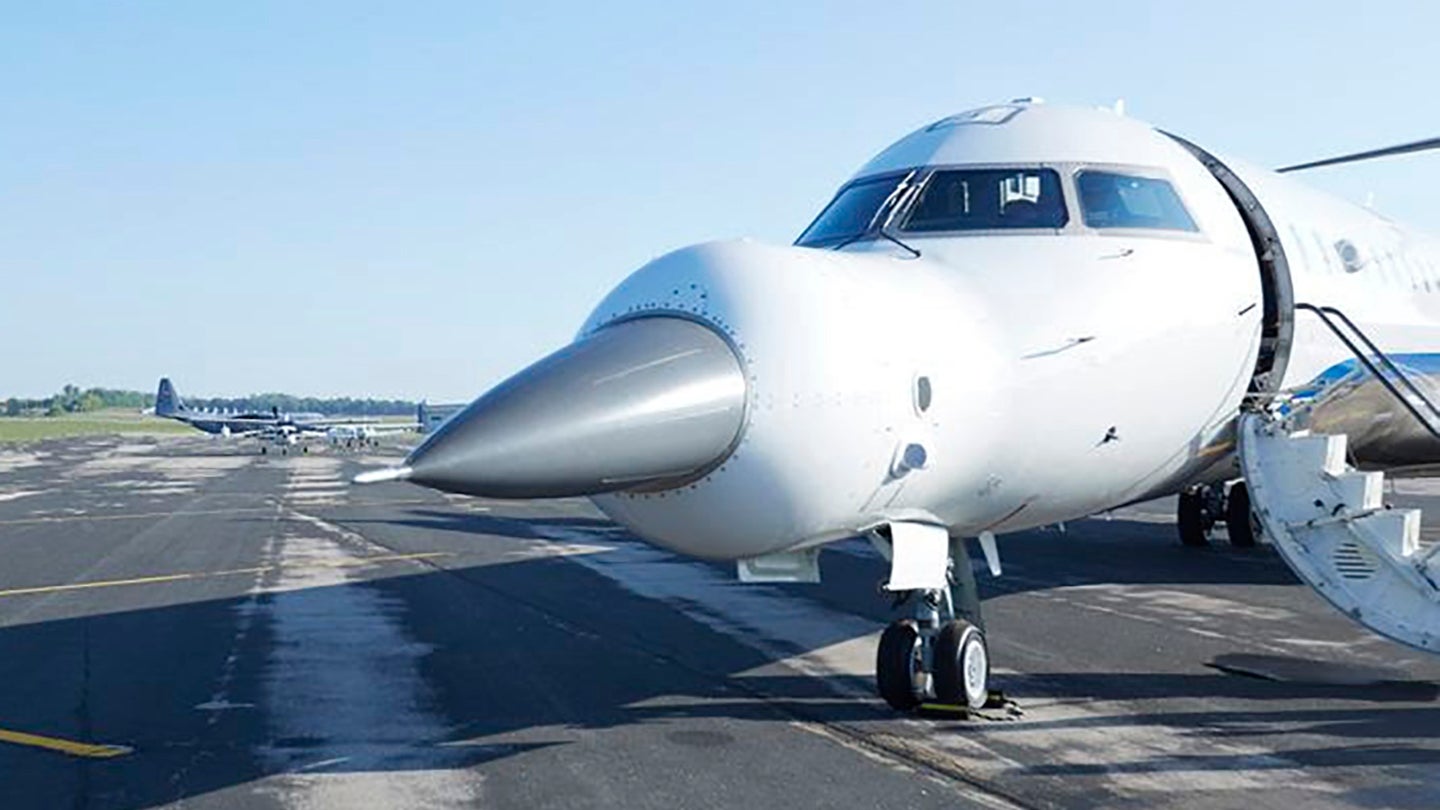Out of all the bizarre-looking testbed aircraft whizzing around these days, Northrop Grumman’s two Bombardier CRJ-700 surrogate test platform aircraft seem to get the most attention. Whenever they show up somewhere, my DMs start filling up with “WHAT IS THIS?!” type of inquiries. It seems that their owner likes to keep tight-lipped about most of the development work that they do, but just today they put out a press release talking about some of their latest exploits, along with the great picture above showcasing the type’s remarkable adaptability.
Many types of aircraft have been turned into testbeds over the decades and fitted with all types of radomes and sensor systems. For instance, Raytheon’s “Voodoo1” Boeing 727 test platform continues to be one of the company’s most valuable assets. The Boeing 757 “Catfish” testbed used for F-22 Raptor stealth fighter avionics development continues to fly to this very day and has even been knocked off by China. Northrop Grumman has an array of types to accomplish these functions, including Gulfstream business jets, but its two CRJ-700s really seem to get around these days.

The two jets, which carry the U.S. civil registration codes N804X and N805X, were developed about a decade ago and often take part in major Large Force Employment (LFE) testing events, working as surrogate platforms for systems and weapons that will eventually find their way on tactical aircraft. Testing those systems in real-world conditions via a flying laboratory is highly beneficial not just for ironing out bugs, but for making the system and its concept of operations and employment even better than promised, as well as finding new ways to leverage their capabilities.
This was precisely the case during this year’s iteration of Exercise Northern Lightning in August where one of Northrop Grumman’s CRJ testbeds sported the F-16’s new AN/APG-83 Scalable Agile Beam Radar (SABR) as it was put through the paces to prove that it can operate with one of the company’s new electronic warfare systems. The press release about this milestone reads in part:
In August, a Northrop Grumman test bed aircraft (pictured) flew with the company’s F-16 Next Generation Electronic Warfare and AN/APG-83 SABR systems in a dense electromagnetic spectrum environment at the Northern Lightning joint training exercise. (Northrop Grumman photo)
“When an EW system and a radar are able to work together fully, as demonstrated with NGEW and SABR, pilots can take advantage of capability without compromise,” said James Conroy, vice president, navigation, targeting and survivability, Northrop Grumman. “With the radio frequency (RF) spectrum becoming increasingly contested, this critical set of capabilities will support the F-16 for many years to come.”
Flying on the company’s test bed aircraft, NGEW and SABR demonstrated full pulse-to-pulse, multi-function interoperability in a contested operational environment. With SABR successfully engaging multiple air and ground targets, NGEW detected and identified a range of advanced threats, employing advanced jamming techniques capable of defeating those threats when required.
At the exercise, the two systems faced a high-density radio frequency environment generated by the Volk Field Combat Readiness Training Center, Joint Threat Emitters. These threat emitters allowed Northern Lightning participants to fly missions under conditions representative of near-peer electromagnetic spectrum environments.
NGEW leverages an open-systems, ultra-wideband architecture, providing the instantaneous bandwidth needed to defeat modern threats. This F-16 system is part of a mature product line of electronic warfare capabilities that can be adapted to virtually any platform. An F-16 will fly with the safety of flight-certified NGEW system in the summer of 2022.
You can read all about SABR in these past features of ours linked here and here.
A source familiar with testbed flight operations tells The War Zone that “no matter what they tell you, you can only do so much in simulation. It is its own thing. That isn’t going to change anytime soon even though simulations are becoming better. The same is true for lab testing. Eventually, you just have to go out and test it in the real world. You would be amazed what we find differs between the real-world environment and one that is predictive of that environment. Flying testbed aircraft allow us to do this more efficiently, both in terms of cost and the ability to test the systems and evolve that testing in real-time with the best minds available present to execute the game plan. They are often a huge component of the success of the system being developed.”
Clearly, this is the thinking behind the CRJs in question, which are reconfigurable to support different development efforts. We have seen them with F-35 radomes (see below), targeting pods, dorsal enclosures, ventral gondolas, and even missile seekers sticking out their modular nose cone assemblies.
So, these unique airframes are not just about testing radars, but pretty much any tactical sensor system, as well as weapons seekers, including those that are destined for anti-radiation and air-to-air missiles, as well as electronic warfare and even communications systems.
With so much military aerospace development currently underway, it is safe to say that we will see much more of these and other testbed aircraft, including new ones, in the future. With the change in digital avionics, you can have multiple relatively discreet airframes flying around testing various state-of-the-art systems that will be critical subcomponents on, say, America’s next stealth bomber, the B-21 Raider, for example, or any other advanced aircraft.
Regardless, these CRJs are definitely versatile tools that Northrop Grumman is quite pleased with and proud of.
Contact the author: Tyler@thedrive.com
